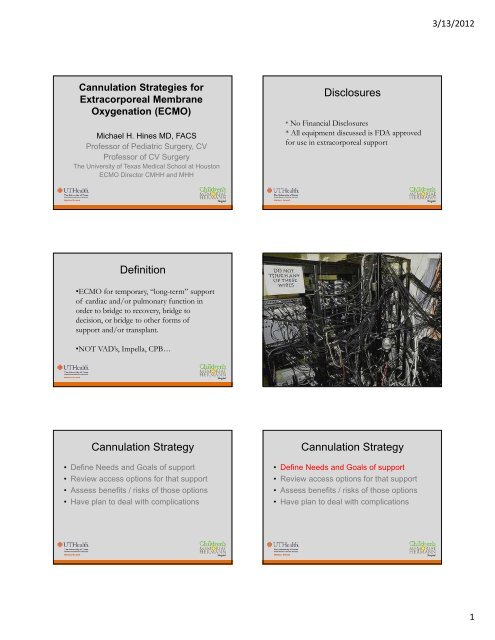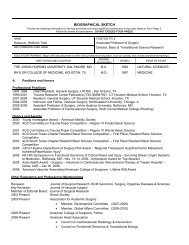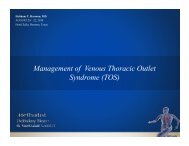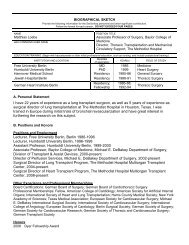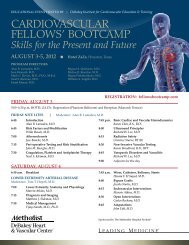Disclosures Definition Cannulation Strategy Cannulation Strategy
Disclosures Definition Cannulation Strategy Cannulation Strategy
Disclosures Definition Cannulation Strategy Cannulation Strategy
You also want an ePaper? Increase the reach of your titles
YUMPU automatically turns print PDFs into web optimized ePapers that Google loves.
<strong>Cannulation</strong> Strategies for<br />
Extracorporeal Membrane<br />
Oxygenation (ECMO)<br />
Michael H. Hines MD, FACS<br />
Professor of Pediatric Surgery, CV<br />
Professor of CV Surgery<br />
The University of Texas Medical School at Houston<br />
ECMO Director CMHH and MHH<br />
<strong>Definition</strong><br />
•ECMO for temporary, “long-term” support<br />
of cardiac and/or pulmonary function in<br />
order to bridge to recovery, bridge to<br />
decision, or bridge to other forms of<br />
support and/or transplant.<br />
•NOT VAD’s, Impella, CPB…<br />
<strong>Cannulation</strong> <strong>Strategy</strong><br />
• Define Needs and Goals of support<br />
• Review access options for that support<br />
• Assess benefits / risks of those options<br />
• Have plan to deal with complications<br />
<strong>Disclosures</strong><br />
* No Financial <strong>Disclosures</strong><br />
* All equipment discussed is FDA approved<br />
for use in extracorporeal support<br />
<strong>Cannulation</strong> <strong>Strategy</strong><br />
• Define Needs and Goals of support<br />
• Review access options for that support<br />
• Assess benefits / risks of those options<br />
• Have plan to deal with complications<br />
3/13/2012<br />
1
General Goals<br />
• Maximum drainage without complications<br />
of venous obstruction<br />
• Unobstructed inflow without distal<br />
ischemia<br />
• Lowest risk of infection<br />
• Mobilization of the patient when possible<br />
<strong>Cannulation</strong> <strong>Strategy</strong><br />
• Define Needs and Goals of support<br />
• Review access options for that support<br />
• Assess benefits / risks of those options<br />
• Have plan to deal with complications<br />
Goals & Needs<br />
• Cardiac Failure – Need VA<br />
• Respiratory Failure – Use VV<br />
– Options – DL and Two cannula<br />
• Combined Cardio-respiratory<br />
– “proximal” VA or VA/V<br />
Cannula options<br />
• MANY BRANDS, TYPES<br />
• Sizes up to 28 French V, for peripheral<br />
• Wire-reinforced to prevent collapse, kink,<br />
(Non OK for inflow)<br />
• Seldinger options? Kits?<br />
3/13/2012<br />
2
Arterial options<br />
• Femoral artery<br />
• Axillary artery<br />
• Carotid Artery<br />
• Aorta<br />
Venous options<br />
• Femoral vein (Intrahepatic IVC)<br />
• Subclavian Vein<br />
• Internal Jugular Vein<br />
• Right Atrium<br />
Arterial options<br />
• How much flow do I need?<br />
• Can I get to it?<br />
• Is it diseased?<br />
• Can I stick it or do I need to cut-down?<br />
• Do I need a graft?<br />
Venous options<br />
• How much flow do I need?<br />
• Can I get to it?<br />
• Is it clotted (DVT)? Or is it injured?<br />
• Can I stick it or do I need a cut-down?<br />
<strong>Cannulation</strong> options<br />
• Percutaneous Seldinger<br />
– All venous, femoral arterial<br />
• Cut-down with Seldinger<br />
– Venous ECPR, Carotid, Femoral (Purse-string)<br />
?Axillary – usually graft<br />
• Cut-down with end-to-side graft<br />
– Axillary, at risk carotid, diseased femoral<br />
• Transthoracic (FTW, High C.O. sepsis)<br />
3/13/2012<br />
3
<strong>Cannulation</strong> options<br />
• Fluoroscopy (contrast)<br />
• Echocardiography<br />
• Vascular Ultrasound<br />
• Radiographs<br />
• MUST KNOW CAPABILITIES and<br />
LIMITATIONS of EACH<br />
<strong>Cannulation</strong> <strong>Strategy</strong><br />
• Define Needs and Goals of support<br />
• Review access options for that support<br />
• Assess benefits / risks of those options<br />
• Have plan to deal with complications<br />
Venous options<br />
• Femoral vein (Intrahepatic IVC)<br />
– Perc / Leg edema, Infection, Immobilization<br />
• Subclavian Vein<br />
– Perc / Size, Arm edema<br />
• Internal Jugular Vein<br />
– Perc, RA flow, DL option/ (SVC syndrome?)<br />
• Right Atrium<br />
– Great flow / Sternotomy, open chest, infection<br />
<strong>Cannulation</strong> <strong>Strategy</strong><br />
• Define Needs and Goals of support<br />
• Review access options for that support<br />
• Assess benefits / risks of those options<br />
• Have plan to deal with complications<br />
Arterial options<br />
• Femoral artery<br />
– Perc / Retrograde, Leg ischemia, Infection<br />
• Axillary artery<br />
– Good flow, less CVA / Graft, Arm overcirculation<br />
• Carotid Artery<br />
– Good flow / Cutdown, ?Ligation, CVA<br />
• Aorta<br />
– Great flow / Sternotomy, infection<br />
Risks / Solutions - Arterial<br />
• CVA (Avoid carotid, or use graft)<br />
– Avoid carotid, or move ASAP (Repair?)<br />
– Caution with diseased aorta<br />
– Caution with femoral retrograde flow<br />
3/13/2012<br />
4
Risks / Solutions - Arterial<br />
• CVA (Avoid carotid, or use graft)<br />
– Avoid carotid, or move ASAP (Repair?)<br />
– Caution with diseased aorta<br />
– Caution with femoral retrograde flow<br />
• Atherosclerosis & Distal ischemia<br />
– Antegrade cannula<br />
– Retrograde (DP, PT) line<br />
– Contralateral graft<br />
• Open Chest (Can tunnel and close)<br />
• Intra-abdominal<br />
IVC is soft, pliable<br />
and collapsible<br />
Risks / Solutions - Arterial<br />
• CVA (Avoid carotid, or use graft)<br />
– Avoid carotid, or move ASAP (Repair?)<br />
– Caution with diseased aorta<br />
– Caution with femoral retrograde flow<br />
• Atherosclerosis & Distal ischemia<br />
– Antegrade cannula<br />
– Retrograde (DP, PT) line<br />
– Contralateral graft<br />
Risks / Solutions - Venous<br />
• Venous Occlusion<br />
– Rare, but don’t occlude BOTH IJ’s<br />
– Anticoagulation probably helps<br />
• Recirculation (VV ECMO)<br />
– Drain from below, infuse into RA (IJ e.g.)<br />
• Venous “chatter”<br />
– RA or Intrahepatic IVC, NOT intra-abdominal<br />
• Intrahepatic IVC<br />
will not collapse<br />
and chatter.<br />
3/13/2012<br />
5
Risks / Solutions - Venous<br />
• Venous Occlusion<br />
– Rare, but don’t occlude BOTH IJ’s<br />
– Anticoagulation probably helps<br />
• Recirculation (VV ECMO)<br />
– Drain from below, infuse into RA (IJ e.g.)<br />
• Venous “chatter”<br />
– RA or Intrahepatic IVC, NOT intra-abdominal<br />
• Occlusion - Accessory drainage?<br />
Special Circumstances<br />
• LV Venting (VA ECMO)<br />
– PV, LA appendage (open sternotomy)<br />
– LV apex (mini L Thoracotomy)<br />
– PA<br />
– Atrial septostomy<br />
• Femoral VA for respiratory Failure – VA-V<br />
• VA ECMO with<br />
Fem-Fem<br />
approach<br />
• Reasonable for<br />
Cardiac<br />
Resuscitation<br />
BUT<br />
• POOR for<br />
Respiratory<br />
Failure<br />
3/13/2012<br />
6
• Oxygenated<br />
Blood up Fem<br />
will likely not<br />
get up into arch<br />
if LV is<br />
ejecting<br />
• VA for arrest,<br />
hemodynamic<br />
• Support Heart<br />
with Fem Fem<br />
VA<br />
• Support Lungs<br />
with addition of<br />
VV limb<br />
• “VA-V<br />
ECMO”<br />
Other principles & Pearls…<br />
• Venous occlusion RARELY a problem…<br />
• Limitation to flow usually venous drainage,<br />
NOT arterial line pressure…<br />
• Commonly TOO SMALL, or TOO LOW…<br />
• Over-insert venous (can always pull back)<br />
• NEVER need an A-cannula as big as V…<br />
• In emergency, use percutaneous<br />
• CAN cannulate under local !!<br />
• Every problem has a potential solution !!<br />
3/13/2012<br />
7


